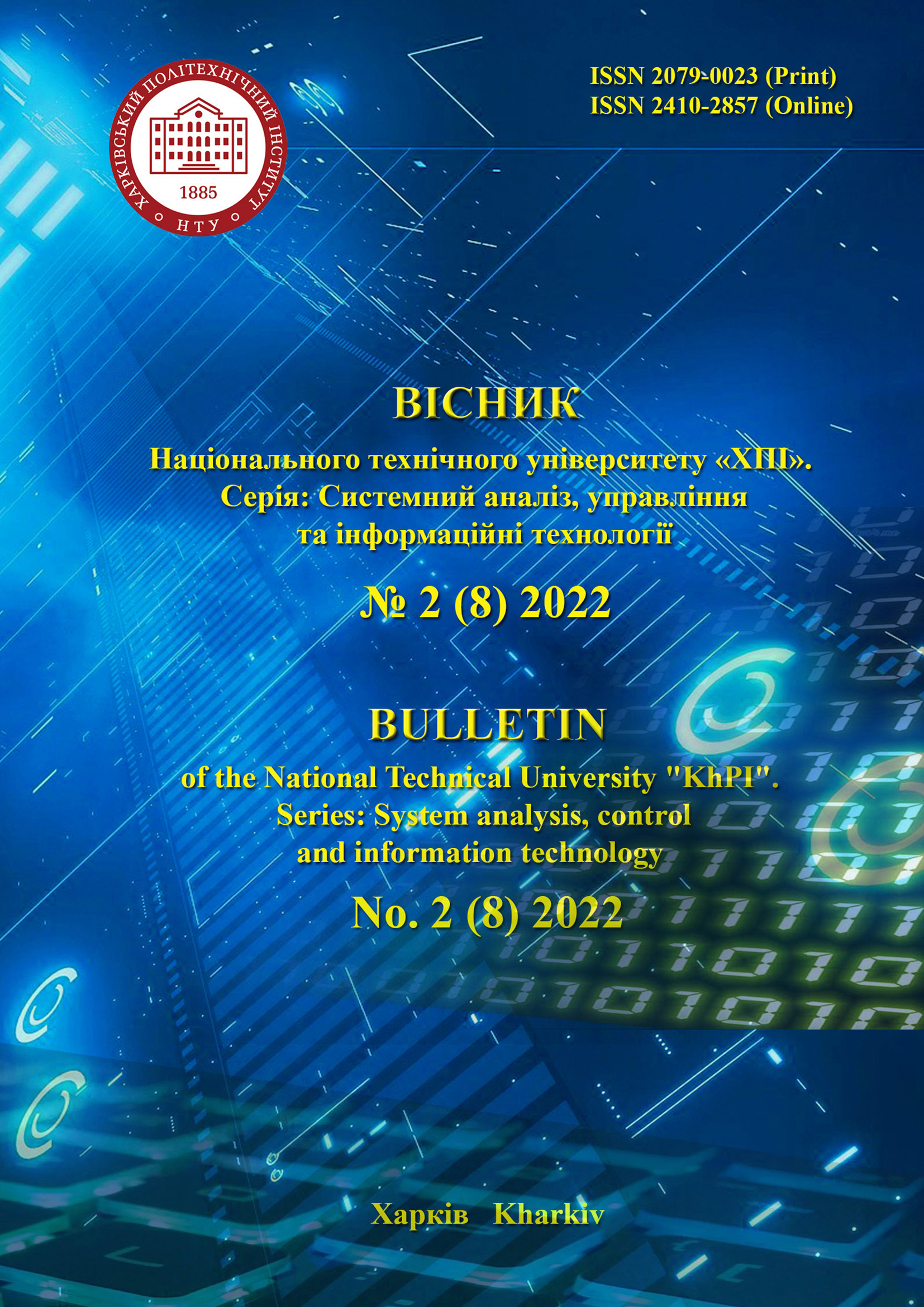DEVELOPMENT OF A MODEL OF INTERFERENCE-RESISTANT DATA TRANSMISSION FOR INFORMATION TECHNOLOGY OF CONTROL OPTIMIZATION OF DYNAMIC SYSTEMS
DOI:
https://doi.org/10.20998/2079-0023.2022.02.09Keywords:
data transmission, immunity, coding, correcting codes, model, dynamic systems, information technologyAbstract
For data transmission channels used in local control systems for various processes, simple and inexpensive methods are needed that will allow the necessary information to be transmitted without errors. Errors that occur in continuous communication channels are one of the main obstacles to the reliable transmission of information. As a result of the analysis of error statistics in discrete channels, it was concluded that single and double errors occur most often. The purpose of this article is to develop a model of interference-resistant data transmission for information technology optimization of control of dynamic systems. The analyzed causes of errors are signal attenuation, noise and various interferences. The resulting transmitted signal is determined by the combination of the useful signal and the interference signal. When considering discrete signals, several causes of errors are highlighted – edge distortions, pulse splitting, and others. Considered methods of combating obstacles: means of operational and preventive nature; means of increasing interference resistance during the transmission of single elements; use of feedback; adding redundancy to the code; tamper-proof coding. It is proposed to combat errors using tamper-resistant coding. Among the interference-resistant codes, redundant block separable systematic codes are selected, which are divided into cyclic codes and Hamming code. The basis of the interference-resistant coding model is the use of a systematic code - a cyclic code or a Hamming code followed by cascade coding. Since the coding model must be adaptively used in different systems, a necessary criterion of the model is its universality. The model should work in different systems without changing the encoding and decoding algorithms. Among the many types of interference-resistant codes, cascade codes are chosen for use. Widespread cascade codes are universal, easily scalable, work stably, have proven themselves well in world practice, therefore they are recommended for use in various information management systems. The implementation of the interference-resistant data transmission model is presented.
References
Nikulina E. N., Severyn V. P., Kotsiuba N. V., Bubnov A. I. Modeluvannya teplovykh procesiv parogeneratora AES dlya informatsiynoi tekhnologii optymizatsii upravlinnya [Modeling of thermal processes of NPP steam generator for information technology of control optimization]. Vestnik Nats. tekhn. un-ta "KhPI": sb. nauch. tr. Temat. vyp.: Sistemnyy analiz, upravlenie i informatsionnye tekhnologii [Bulletin of the National Technical University "KhPI": a collection of scientific papers. Thematic issue: System analysis, management and information technology]. Kharkiv, NTU "KhPI" Publ., 2021, no. 1 (5), pp. 56–61.
Nikulina E. N., Severyn V. P., Kotsiuba N. V. Rozrobka informatsiynoi tekhnologii optymizatsii upravlinnya skladnymy dynamichnymy systemamy [Development of information technology for optimizing the control of complex dynamic systems]. Vestnik Nats. tekhn. un-ta "KhPI": sb. nauch. tr. Temat. vyp.: Sistemnyy analiz, upravlenie i informatsionnye tekhnologii [Bulletin of the National Technical University "KhPI": a collection of scientific papers. Thematic issue: System analysis, management and information technology]. Kharkiv, NTU "KhPI" Publ., 2020, no. 2 (4), pp. 63–69.
Zakharchenko N. V., Gorokhov S. M., Kochetkov A. V. Informatsijni parametry pozitsijnyh kodiv [Information parameters of positional codes]. Odesa, ONAS Publ., 2018. 212 p.
Bleihut R. Theory and Practice of Error Control Codes. 1983. 576 p.
Losev Yu. I., Shmatkov S. I. Osnovy teotiji peredachi informatsiji [Fundamentals of the theory of information transfer]. Kharkiv, KhNU named V. N. Karazina Publ., 2013. 290 p.
Yue Tang, Tian Mao, Bing Jiang Design and Experiment of Multiresolution Composite Digital Array Antenna. Journal of Radars. 2016, vol. 5, no. 3, p. 265.
Banket V. L., Ivashchenko P. V., Ishchenko M. O. Zavadostijke koduvannja v telekomunatsijnyh systemah [Interference-resistant coding in telecommunication systems]. Odesa, ONAZ named O. S. Popova Publ., 2011. 100 p.
Zhurakovsky Yu. P., Poltorak V. P. Teorija informatsiji ta koduvannja [Theory of information and coding]. Kyiv, Vyshcha shk. Publ., 2001. 255 p.
Kozhevnikov V. L., Kozhevnikov V. L. Teorija informatsiji ta koduvannja [Theory of information and coding]. Dnipro, National Mining University Publ., 2011. 108 p.
Jones G. A., Jones J. M. Information and Coding Theory. London, Springer-Verlag Publ., 2000. 210 p.
Sharov V. O., Berdnikov A. G. Modeluvannja koruguvalnogo kaskadnogo kodu v kanalah peredachi danyh systemy upravlinnja [Simulation of the correcting cascade code in data transmission channels of the control system]. International scientific and technical conference "Computer simulation in scientific technologies". Kharkiv, KhNU named V. N. Karazina Publ., 2021, pp. 298–302.
Yurong Guan, Zhihua Hu, Chen Chen, Xiaoming Zhu. An anti-noise transmission algorithm for 5G mobile data based on constellation selection and channel joint mapping. Alexandria Engineering Journal. 2021, vol. 60, issue 3, pp. 3153–3160.
Zhambaeva O., Sailauqizy Zh. Noise immunity of data transmission over digital communication channels using convolutional coding. Engineering Journal of Satbayev University. 2021, no. 143(2), pp. 244–251.
Downloads
Published
How to Cite
Issue
Section
License
LicenseAuthors who publish with this journal agree to the following terms:
- Authors retain copyright and grant the journal right of first publication with the work simultaneously licensed under a Creative Commons Attribution License that allows others to share the work with an acknowledgement of the work's authorship and initial publication in this journal.
- Authors are able to enter into separate, additional contractual arrangements for the non-exclusive distribution of the journal's published version of the work (e.g., post it to an institutional repository or publish it in a book), with an acknowledgement of its initial publication in this journal.
- Authors are permitted and encouraged to post their work online (e.g., in institutional repositories or on their website) prior to and during the submission process, as it can lead to productive exchanges, as well as earlier and greater citation of published work (See The Effect of Open Access).


